Physical Address
304 North Cardinal St.
Dorchester Center, MA 02124
Anomalies of the corpus callosum and septum pellucidum are disorders of prosencephalic midline development. Midline prosencephalic development peaks at 7 to 12 weeks' gestation and includes the formation of the chiasmatic, commissural, and hypothalamic plates, enabling formation of the corpus callosum (12 to 20 weeks) and septum pellucidum. Corpus callosum and septum pellucidum anomalies are often associated with other brain abnormalities.
The corpus callosum represents the major telencephalic commissure. The telencephalic commissures are corticocortical bundles of white matter extending from one hemisphere to the other, typically in a symmetric fashion. The other interhemispheric commissures are the anterior and the hippocampal commissures. The corpus callosum is composed of four parts (from front to back): rostrum, genu, body, and splenium ( Fig. 34.1 ). Developmental abnormalities of the corpus callosum include complete or partial agenesis of the corpus callosum (ACC); partial ACC is also referred to as hypogenesis (or dysgenesis ).
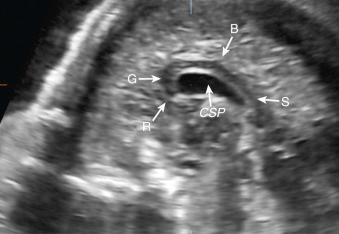
The prevalence of corpus callosum anomalies varies significantly in different studies. Depending on the population and the diagnostic criteria, 0.3% to 0.7% in the general population and 2% to 3% in developmentally disabled individuals have been reported.
The anterior part of the corpus callosum develops along a fusion line composed of specialized groups of glial cells, the glial sling, that guide commissural axons of the frontal lobes through the interhemispheric meninges toward the contralateral hemisphere. Commissural fibers from the temporooccipital lobes cross the midline along the anterior commissure, while posterior occipitoparietal fibers cross along the scaffold provided by the hippocampal commissure, resulting in the callosal splenium. Thus, contrary to common misconception, there is no anteroposterior growth of the corpus callosum; rather the corpus callosum forms by two separate segments that eventually coalesce to fuse the complete commissural plate. If the normal developmental process is disturbed, the corpus callosum may be completely or partially absent (hypogenetic).
The knowledge of the organogenetic process helps differentiate a developmental injury (hypogenesis) from an acquired one (destruction). The latter mechanism usually occurs in association with hypoxic-ischemic injury and infectious causes. Two types of congenital callosal abnormalities can then be distinguished. In the first type, the axons are present but are unable to cross the midline; they form large aberrant fiber bundles (“Probst bundles”) along the medial hemispheric walls. In the second type, which is less frequent, the axons fail to form, and no Probst bundles are found. The etiology of ACC is very heterogeneous. Identified causes are chromosomal, monogenic, and teratogenic. Chromosomal abnormalities are present in 20% of ACC, especially trisomies 18 and 13. More than 250 syndromes involving ACC have been reported and about 15 genes have been identified as responsible for AAC. Some environmental and metabolic factors also have been implicated in ACC, such as fetal cytomegalovirus and rubella infections and fetal alcohol exposure. Most isolated ACC cases are sporadic. However, autosomal recessive or dominant transmission occurs in about 3% (personal data), which may justify magnetic resonance imaging (MRI) assessment of the parents' corpus callosum.
Clinical features of ACC include mental retardation, easily controlled epilepsy, and behavioral disorders. Clinical findings vary widely, ranging from asymptomatic with normal intellectual capacities to severe mental retardation.
Although the overall prognosis of ACC is controversial, several studies reported a worse prognosis in the presence of additional anomalies. Cases of isolated ACC seem to carry a better prognosis, but the clinician must be cautious when assessing the fetal and neonatal prognosis considering the small number of fetal series reported in the literature. Even with extensive prenatal analysis it is difficult to ascertain whether the malformation is truly isolated.
A review article was recently dedicated to neurodevelopmental outcome in truly isolated ACC found only six studies using appropriate data (MRI before and after birth, neurodevelopmental assessment with standardized tests). The outcome was favorable in 75.4% of cases, with moderate disability in 13% and severe disability in 11.6% of cases. The prognosis of partially isolated ACC was not significantly different from that of isolated complete forms.
In individuals with ACC, subtle neuropsychologic, perceptual, and motor defects can emerge later in life. Long-term follow-up is important, especially with regard to social interactions and school performance, to provide better prognostic information to families.
The corpus callosum can be shown with ultrasound (US), but some degree of technical skill is required because it is not apparent in the standard axial planes, and additional coronal and particularly sagittal planes are required. In fetuses in cephalic presentation, the transvaginal approach is preferred; in fetuses in breech presentation, a transfundal approach is suggested. Using a three-dimensional multiplanar technique can also be helpful because it offers a more accurate identification of the midsagittal plane, and navigation in the other two simultaneous orthogonal planes may permit a better evaluation of the midline prosencephalic structures ( Fig. 34.2 ). In axial planes, the diagnosis is based on the presence of indirect signs. Because the corpus callosum shares a common anatomic and embryogenetic formation with the septum pellucidum, complete ACC is commonly associated with a hypoplastic or absent cavum septi pellucidi (CSP).
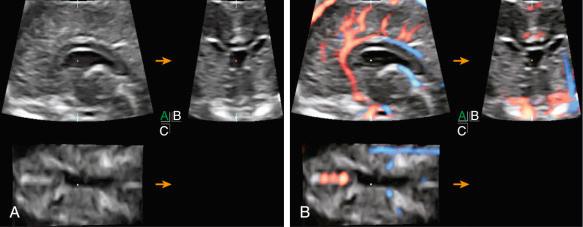
At the second-trimester anomaly scan, ACC may be suspected when the CSP is not visualized on the axial transventricular view ( Fig. 34.3 ). The suspicion of ACC is supported further by the recognition of other indirect signs, such as (1) colpocephaly (dilatation of the atria and occipital horns of the lateral ventricles, owing to the absence of the splenium and to a defect of the intrinsic association bundles of the occipital lobe) ( Fig. 34.4 ) and (2) increased separation of the hemispheres with the bodies of the lateral ventricles parallel to each other and shifted laterally (see Fig. 34.4 ). Dorsal elevation of the third ventricle can be also present. On coronal sections of the fetal brain, the indirect signs are mainly apparent in the frontal horns, which are separated more than usual and show concave medial borders ( Fig. 34.5 ). This appearance is due to the compression exerted by a large longitudinal bundle of fibers representing the callosal fibers that fail to cross the hemispheres, are rerouted parasagittally, and run parallel to the midline. This abnormal bundle, the longitudinal bundle of Probst, runs parallel to the medial walls of the lateral ventricles and enlarges and deforms their medial borders, especially at the level of the frontal horns. Each of these indirect signs can be present in isolation, which in part explains the frequently missed diagnosis of ACC.
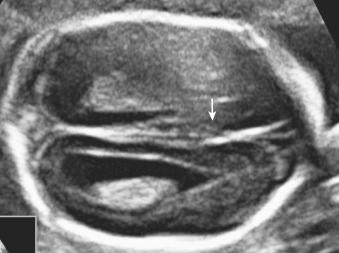
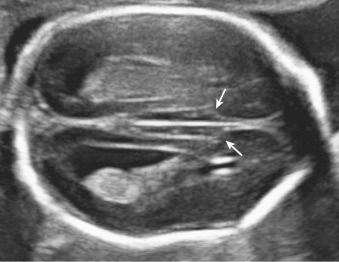
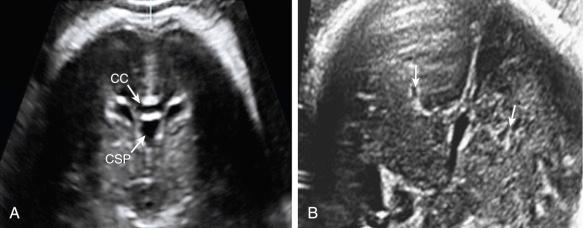
A definitive diagnosis of ACC relies on direct visualization : demonstration of the absence of the corpus callosum on midsagittal and coronal views of the fetal brain. In particular, the midsagittal plane shows absence of the corpus callosum ( Fig. 34.6A ) and, in advanced gestation or postnatally, an atypical radiating appearance of the median sulci, which converge toward the third ventricle (see Fig. 34.6B ). In this view, the cingulate gyrus can be recognized, or appears incomplete.
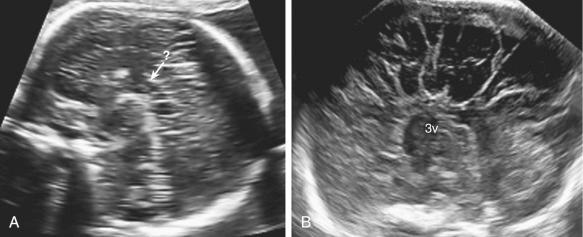
Become a Clinical Tree membership for Full access and enjoy Unlimited articles
If you are a member. Log in here